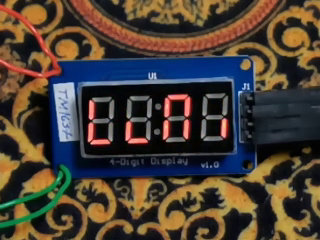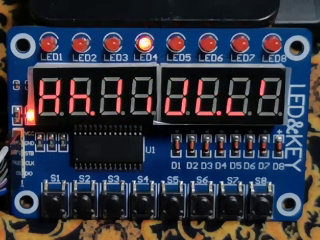# Titan Micro LED controller driver
[](https://crates.io/crates/tmledkey-hal-drv)
[](https://docs.rs/tmledkey-hal-drv)
Titan Micro is a Chinese manufacturer that produce several type of controllers for [7 segment LED displays](https://en.wikipedia.org/wiki/Seven-SEG_display) with additional keyboard key scan functionality.
At least next controller variants are exist on the market:
* TM1636 - 2 wire interface, 4 displays, 16 keys
* TM1637 (popular) - 2 wire interface, 6 displays, 16 keys
* TM1638 (popular) - 3 wire interface, 8 displays (10 segments), 24 keys
* TM1639 - 3 wire interface, 8 displays (12 segments ?), 8 keys
* TM1640 - 2 wire interface, 16 displays, no keys
This driver implements low level functions to send/read data with 2 or 3 wire interface.
User friendly API would be implemented for popular controller models later.
# Project status and future plans
Available functionality:
* Support 2 and 3 wire interfaces, tested on TM1637 and TM1698
* Writing bytes to MCU
* Reading key scan bytes from MCU
* Basic utility and animation features are present
Hardware crate was tested on:
* TM1637 clock module
* TM1638 module with 8 displays, 8 buttons and 8 additional LEDs
* STM32 Blue Pill
* Raspberry Pi
Current functionality looks stable, but implementation is extremely low level.
That is mostly because I see no reason to do more friendly API
until HAL and it's implementations would stabilize.
Right now my goal is to keep it stable and working between HAL updates.
I really do hope that complexity of API is not a big issue. Current HAL state and embedded programming
is suited only for hardcore, crazy, masochist developers who should be OK with my code.
# Examples
This is how code from examples works.
Click on image to view animation.

 # Licensing
This product is licenses under **almost MIT license** but with plumbus exception.
# Licensing
This product is licenses under **almost MIT license** but with plumbus exception.

 # Licensing
This product is licenses under **almost MIT license** but with plumbus exception.
# Licensing
This product is licenses under **almost MIT license** but with plumbus exception.